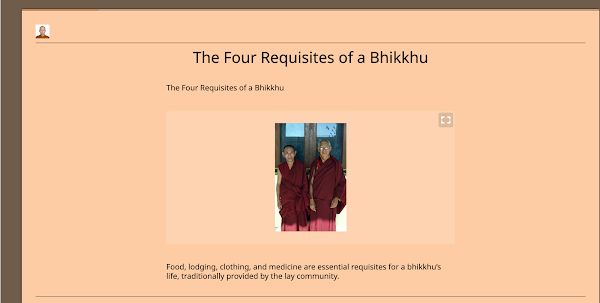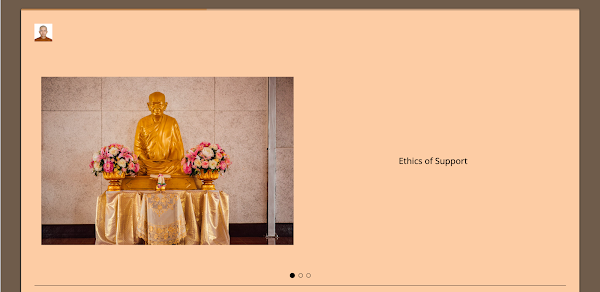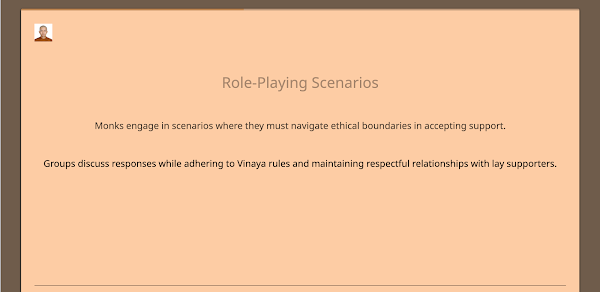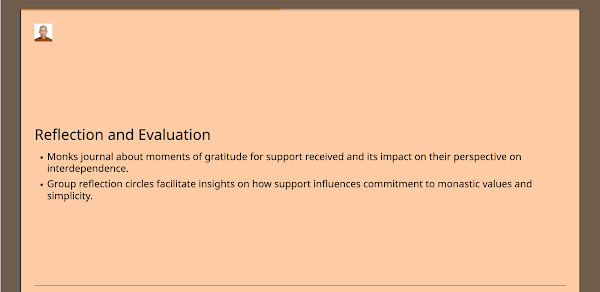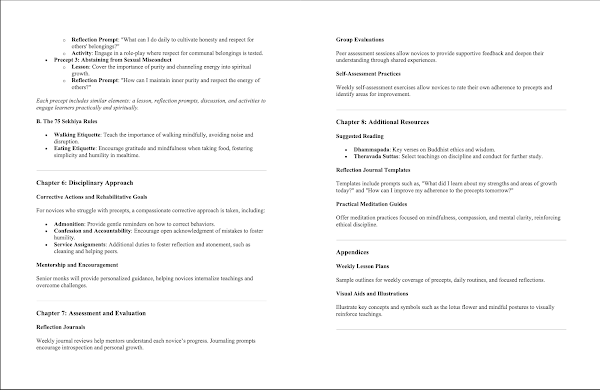anekajātisaṃsāraṃ sandhāvissaṃ anibbisaṃ gahakāraṃ gavesanto dukkhājāti punaṃppunaṃ sabbā te phāsukā aggā gahakūṭaṃ visaṅkhataṃ visaṅkhāra gataṃ cittaṃ taṇhānaṃ khaya majjyagā
ဝန္ဒာမိ
vandāmi cetiyaṃ sabbaṃ, sabbaṭṭhānesu patiṭṭhitaṃ. Ye ca dantā atītā ca, ye ca dantā anāgatā, paccuppannā ca ye dantā, sabbe vandāmi te ahaṃ.
Monday, November 11, 2024
"What are a Bhikkhu's Means of Support?"
Objective: To enable monks to understand the concept of support in monastic life, specifically how they rely on the laity for their basic needs, fostering gratitude and a deeper understanding of interdependence within the Buddhist community.
Purpose: This lesson will explore the essentials that sustain a bhikkhu, how they are supported by the lay community, and the ethical relationship involved in this exchange.
Methodology: Experiential Learning Cycle (ELC) to reflect on interdependence, practice gratitude, and appreciate the simplicity of monastic life.
All Rights are Reserved By Author Sao Dhammasami
(Teaching With Compassion)
Wednesday, November 06, 2024
"The Integration Procedure" (Upasampadä), through which a novice becomes a fully ordained monk (bhikkhu).
"The Integration Procedure" (Upasampadä), through which a novice becomes a fully ordained monk (bhikkhu).
ရဟန်းလောင်း တစ်ပါးကို သိမ်ထဲမှာ သံဃာဘောင်သို့ မသွတ်သွင်းမီ
ပြုမူဆောင်ရွက်ဖွယ်ရာ ကိစ္စရပ်များအတွက်
သင်ကြားရေးစီမံချက် Lesson Plan Design
Sao Dhammasami
Teaching With Compassion
Wednesday, October 30, 2024
သင်ကြားရေး ၊ သုတေသန နဲ့ ပုံနှိပ်ထုတ်ဝေရေး
သင်ကြားရေး
သုတေသန
ပုံနှိပ်ထုတ်ဝေရေး
အုပ်ချုပ်ရေးဆိုပြီး အခြေခံအားဖြင့် ပညာရေး သဘောသဘာ၀ ၄ ခု ကို တည်ထားလိုက်တယ်ဆိုပါစို့။
ခေါင်းစဉ်ကတော့ ၄ ခုကွဲနေပေမယ့် တစ်ခုနဲ့တစ်ခုဟာ ချိတ်ဆက်နေတာမျိုးပါ။
ပေါ်လစီ ဆိုတဲ့ စကားရပ်ဟာ သင်ကြားရေး၊သုတေသန ၊ပုံနှိပ်ထုတ်ဝေရေး၊အုပ်ချုပ်ရေး တို့ ခရီးဆက်နိုင်ဖို့ အချုပ်််ဖြစ်ပါတယ်။
ဘယ်လိုစနစ်နဲ့ သွားကြမလဲဆိုတဲ့ System Set Up ဟာ Institution ရဲ့ ပေါ်လစီအပေါ်မူတည်ပါတယ်။
The Next 20 Years Later မှာ ဘာအသီးအပွင့်ကိုမြင်ချင်လဲဆိုတဲ့
အနာဂတ်အမြင် ပေါ်မူတည်ပြီး
ပန်းတိုင် ကိုမရောက်ရောက်အောင်
Objective တွေ Mission တွေ ချမှတ်ကြရတာဖြစ်ပါတယ်။
ဒီကနေ့မှာတော့ အခြားအကြောင်းအရာတွေထက်
သင်ရိုးညွန်းတမ်း ၊ ပြဌာန်းစာအုပ် ၊ ဆရာကိုင် ၊ ဆရာလမ်းညွန် ၊ သင်ကြားရေးစီမံချက် ၊ အကဲဖြတ်စိစစ်သုံးသပ်ခြင်းဆိုတဲ့
အကြောင်းအရာကို အဓိက HighLight ထား ပြီး တင်ပြ မျှဝေပေးသွားမှာဖြစ်ပါတယ်။
အောက်က တွဲတင်ထားတဲ့ တစ်နာရီစာ သင်ကြားရေး (သင်ခန်းစာ စီမံချက်) ကိုနမူနာကြည့်ခြင်းအားဖြင့် စာရေးသူ ပေးချင်တဲ့ ပညာရေးသဘောတရားတွေ ပညာရေးသဘာ၀တွေ ပညာရေးစိတ်ပညာတွေ
ကို သင်ကြားရေး ၊ သုတေသန နဲ့ ပုံနှိပ်ထုတ်ဝေရေးတို့အတွက်
ဘယ်ပုံဘယ်နည်း Link ဖြစ်နေတယ်ဆိုတာ ခန့်မှန်းသိရှိနိုင်မယ်လို့ ယူဆပါတယ်။
ပြဌာန်းစာအုပ်တစ်အုပ်ကိုရေးသားတော့မယ်ဆိုရင် ထည့်သွင်းစဉ်းစားစရာ အဓိကအချက်တွေ အများကြီးထဲက အချို့သော ဥပမာများကိုသာ ဒီကနေ့မှာ မျှဝေပေးသွားမှာဖြစ်ပါတယ်။
Expanding the Policy Framework ချတဲ့အခါမှာ
၁. encompassing accessibility,
၂. non-discrimination
၃. respectful behavior across all learning environments.
ရေးတဲ့ ပြဌာန်းစာအုပ်ပါအချက်အလက် တွေ ၊ သင်ကြားရေးစီမံချက်တွေ ၊ဟောပြောပို့ချမူ( Teacher Training and Manual Guide Line) တွေမှာ အပေါ်က ဖေါ်ပြထားတဲ့ အချက်ကြီး ၃ ချက်ကို အခြေခံတည်ဆောက်ရပါတယ်။ လူမျိုးရေး ၊ အသားအရောင် ကျားမ စသည့် ခွဲခြား ဆက်ဆံမူ တွေ မဖြစ်စေတဲ့ ပြဌာန်းစာအုပ်များဖြင်္စအောင်ကျိုးစားရပါတယ်။
တနည်းအားဖြင့် Peace ကို ဦးတည်တဲ့ ရည်ရွယ်ချက်မျိုးဖြစ်အောင် ရေးသားဖို့လိုအပ်ပါတယ်။
Enhanced Ground Rules for Classrooms and Beyond
၁. collaboratively created
၂. enforced using restorative practices,
၃. focusing on learning rather than punishment.
ဆုပေးဒဏ်ပေစနစ်ကိုကျင့်သုံးတယ်ဆိုပေမယ့် နာမ်ပိုင်းဆိုင်ရာ ကိစ္စရပ်တွေဖြစ်တာကြောင့် စာမရတာ ၊ မမှတ်မိတာ ၊ စတဲ့ကိစ္စတွေပေါ်ပေါက်လာတဲ့အခါ ရုပ် နဲ့ စိတ်တွေကို နာကျဉ်စေတဲ့ ပြစ်ဒဏ် ချဆုံးမမူမျိုး
လူရှေ့သူရှေ့အရှက်ခွဲ ခံရတာ ( သူများအားနည်းချက်ကို အခွင့်ကောင်းယူပြီး အကွက်ဝင်လာရင် ဖိနှိပ်လိုက်မယ်ဆိုတဲ့ အလေ့အကျင့်ကို ကျင့်ပေးလိုက်သလို ၊ တစ်ခုခုဖြစ်လာတိုင်း အာဏာသုံး အင်အားသုံး ညှင်းပန်း မူ ဘက်ကို မသိမသာ သင်ယူမူရသွားတာမျိုး) မဖြစ်ရလေေအာင်
အခန်းဆုံးစစ်ဆေးမူတွေမှာ နားလည်မူနဲ့ တတ်ကျွမ်း သိရှိမူ ကို အသားပေးတဲ့ စိစစ်အကဲဖြတ်သုံးသပ်မူ ( Exam ) စနစ်မျိုး ကျင့်သုံးသင့်ပါတယ်။
စာသင်ကြားပေးရုံသာမက စာရိတ္တ ကိုပါ ပဲ့ကိုင်ရာ ဌာန ဖြစ်တဲ့အတွက် Individual Skills Development တွေတင်မက Group Wok , Pair Work , Collaborative Work တေွွွွကို သင်ခန်းစာ သင်ကြားသူတွေက ဆောင်ရွက်ပေးမှသာ လူနေမူဘ၀မှာ သူ့အမြင် ကိုယ့်အတွေး မတူညီတဲ့ Background , Religious , Race စတဲ့ မတူကွဲပြားမူတွေမှာ ငြိမ်းချမ်းစွာ ပြောဆိုဆက်ဆံရေး Step Up and Step Up , Mutual Respect and Understanding ဆိုတဲ့ Life Skills တွေကို ပါ ငယ်ငယ်ကတည်းက
Training လုပ်ပေးဖို့ရာ ဆရာတွေ ဆီမှာ အရည်အသွေးတွေ
အရည်အချင်းတွေရှိနေဖို့လိုအပ်ပါသည်။
ဒါတွေက လောက နိုင်ငံ ဥပဒေတွေနဲ့ပါ ချိတ်ဆက်နေတဲ့ သဘောတရားတွေဖြစ်ပါတ.်
ပြဌာန်းစာအုပ် တွေရေးရတာ လွယ်သလားဆိုတော့
ဘယ်လွယ်မလဲ
တော်ရုံ ဗဟုသုတ တော်ရုံအတွေ့အကြုံနဲ့ ရေးလို့ရတဲ့အရာ မဟုတ်ပါဘူး
သင်ကြားရေးအတွေ့အကြုံ ၊
ဆရာဖြစ်မွန်းမံသင်တန်းပို့ချဖူးတဲ့အတွေ့အကြုံ ၊
စီမံခန့်ခွဲမူအတွေ့အကြုံ ၊
သင်ရိုးညွှန်းတမ်းရေးဆွဲဖူးတဲ့အတွေ့အကြုံ ၊
စိစစ်အကဲဖြတ်သုံးသတ်ခြင်းလုပ်ငန်းအတွေ့အကြုံ
သုတေသနအတွေ့အကြုံ
ပုံနှိပ်ထုတ်ဝေရေးအတွေ့အကြုံ
စသည်ဖြင့် အဲဒီနယ်ပယ်တွေမှာ အတွေ့အကြုံ နဲ့ ဆည်းဖူးမူ အထိုက်အလျောက်မှ မရှိနေပဲနဲ့ ဒါတွေကိုရေးသားဖို့ဆိုတာ
မဖြစ်နိုင်ပါဘူး
Professional အလုပ်ဖြစ်သလို Expert ဖြစ်နေရုံမကဘူး
ဇွဲ ဝီရိယ ၊ စိတ်ရှည်မူ ၊ သည်းခံမူ အပြင် စေတနာ ထက်သန်တဲ့ သူတွေ မှ ဆောင်ရွက်နိုင်တာမျိုးပါ
အင်မတန် အသေးစိတ်သလို အနုလဲစိတ်ပါတယ်
ဘက်ဘောင်းစုံ Sector ပေါင်းစုံကနေ တွေးတောနိုင်တဲ့ဉာဏ်ပညာ လဲရှိဖို့လိုပါသေးတယ်
စာရေးသူဟာ Expert လားဆိုတော့မဟုတ်ပါဘူး
ကြိုးစားလျှောက်လှမ်းနေဆဲ သာမာန်ရဟန်း ငယ်တစ်ပါးမျှသာဖြစ်ပါတယ်
ဒါတွေဟာ ဒီနိုင်ငံ ဒီသာသနာရဲ့အနာဂတ် နဲ့ တိုက်ရိုက်သက်ဆိုင်နေတာမျိုး
မလွယ်ပါဘူး ၊ ခက်သလားဆိုတော့ လဲမခက်ပါဘူး
Building Ethical Awareness ဒါကလဲ ထည့်သွင်းစဉ်းစားရတဲ့ံအချက်အလက်တွေဖြစ်ပါတယ်
၁. through real-life scenarios
၂. empathy exercises
၃. a structured ethical decision-making model.
ဗြဟ္မစိုရ် တရား ၄ ပါးထွန်းကားတဲ့ ဆုံးဖြတ်ချက် ချနိုင်မူမျိုးတွေ သင်တန်းသားတွေရဲံ နေ့စဉ်လူနေမူဘ၀တွေမှာ ဖြစ်ဖို့ရာ
သင်ခန်းစာ
သင်ကြားရေး
စီမံအုပ်ချုပ်ရေး တွေဟာ အမြဲတမ်းမျက်ခြေမပျက်ပဲ ညွန်းတမ်းတွေကို ရေးသားသီကုံးကြရတာမျိုးပါ။
Refining the Code of Conduct ကိုလဲ ထည့်သွင်းစဉ်းစားရပါတယ်
၁. to include moral ethics
2. zero tolerance for harassment
3. recognition of positive behavior.
အဟိံသ ဆိုတဲ့ မူဝါဒ ယောနိသော မနဿိကာရ ဆိုတဲ့ စိတ်တွေဖြစ်အောင်
Logical and Critical Thinking Class ဖြစ်အောင်ဦးတည်ရေးဖွဲံရတာမျိုးပါ။
၂၀၂၄ ခုနှစ်ကိုရောက်နေပြီဖြစ်တဲ့အတွက် ဒီလို ခေတ် ဒီလို အိုင်တီစနစ်မျိုးမှာ Applying International and Child Law Principles တွေကို ပါ ထည့်သွင်းစဥိးစားထားမှ ဒီသာသနာ နိုင်ငံတကာ ကို ပြန့်ပွားအောင် ဆောင်ရွက်တဲ့အခါမယ် သူများတိုင်းတာတဲ့ ပေတံ တွေ စံ နှုန်းထားတွေနဲ့ကိုက်ညီနေအောင် နိုင်ငံတကာနဲ့ ဘောင်ဝင်တန်းဝင်တဲ့ ပြဌာန်းချက်စာအုပ်တွေဖြစ်ဖို့လိုပါတယ်။ မူရင်း ကျမ်းစာ ဘုရားဟော အဆုံးအမများကိုတော့ နည်းနည်းမှ အပွန်းအပဲ့ အထိအရှမခံပဲ Instituitional Culture တွေ နဲ့ကိုက်ညီတဲ့
1. Integrating international and child law principles
2.using age-appropriate language and positioning educators as student advocates. ဆိုတဲ့ ပေါ်လစီကို ထည့်သွင်းရေးသားရပါတယ်။
Deepening Textbook Content တွေမှာ တော့ မူရင်းဘုရားဟော ဒေသနာတော်တွေကို အောက်ဖေါ်ပြပါ ဗျူဟာတွေနဲ့ သင်ကြားနိုင်ဖို့ရာ ရေးသားရပါသေးတယ်
၁. with a thematic structure
၂. diverse case studies
၃. project-based learning. တွေဖြစ်အောင် တနည်းအားဖြင့် Active Learning ပတ်ဝန်းကျင်ဖြစ်အောင် Text Book Content တွေကို
Create လုပ်တတ်တဲ့ ဉာဏ်ပညာ ရှိဖို့လဲလိုအပ်ပါသေးတယ်။
Lesson Plan Expansion အနေနဲ့ သင်ခန်းစာပြီးသွားတဲ့အချိန်မယ် ဆက်စပ်တဲ့ စာအုပ်စာတမ်းတွေကို အကြံပြုလမ်းညွန်ပေးတာ
အခြားသော တင်ဆက်ပုံမျိုးနဲ့သူတို့ဘာသာသူတို့ တီထွင်ဖန်တီးတင်ဆက်တဲ့ ပုံမျိုးနဲ့ How To Apply on Futrue ဆိုတဲ့ Apply Pratical တွေကို ဖေါ်ဆောင်ပေးနိုင်ခြင်းအား ဖြင့် အနာဂတ် သာသနာအတွက် ခေါင်းဆောင်မူ အတတ်ပညာတွေ တိုးပွားလာမှာလို့ယုံကြည်ပါတယ်
၁. incorporating reflective journaling
၂. role-playing
၃. collaborative group work. ဒါလေးတွေက အဲဒီအတွက် နမူနာလေးတွေပါ။
အုပ်ချုပ်သူတွေအနေနဲ့ Teacher Manual Handbook Details ကို ပြဌာန်းပေးထားရမှာဖြစ်သလို သင်ထောက်ကူပစ္စည်းတွေ ကိုလဲ စိတ်ကြိုက် တီထွင် ပေးခြင်း ၊ Creative Work ဖြစ်အောင် Supporting ပေးခြင်း စတာတွေစဉ်ဆက်မပြတ် တွေ့ဆုံဆွေးနွေးအဖြေရှာပေးနေဖို့ ရာ လိုအပ်လှပ်တယ်။
၁. including guidance on sensitive topics
၂. alternative assessment methods
၃. resources for new teachers.
Regular Meeting တှေ ကို ကြောငျးသား ၊ဆရာ ၊ အုပျခြုပျမူ စီမံခနျံခှဲမူတှေ နဲ့ ပုံမှနျတှေံဆုံအဖွရှောမူ စနစျမြိုးတညျထောငျဖို့ရာလိုအပျပါတယျSuggestion Box တှေ တညျဆောကျတာမြိုးပါ။
Additional Ideas for Engagement and Practical Application ဒါကအင်မတန်အရေးကြီးပါတယ်
guest speakersခေါ်ပေးတာတွေ simulated governanceဖြစ်အောင် လုပ်ပေးတာတွေ student-led workshops ပြုခွင့်ပေးတာတွေမျိုးပေါ့
industrial Visit တွေ field Trips တွေ စတာတွေပေါ့ကွယ်
ဒီနေ့အတွက်တော့တော်သေးပြီ
Sao Dhammasami
Teaching With Compassion !
Monday, October 28, 2024
Introduction to Monastic Precepts and Rules for Novices
Text Book ကတော့ပြီးသွားပါပြီ
ဆရာကိုင်လမ်းညွှန်ကတော့ လဲပြီးပါပြီ
Lesson Plan ကတော့ အနည်းငယ်မျှ အချောသတ် တည်းဖြတ်ရန်ကျန်နေသေး။
အတတ်နိုင်ဆုံးနေ့စဉ်လူနေမူဘ၀မှာ အသုံးချဖြစ်အောင် အခြေခံတဲ့
ပြဌာန်းစာအုပ်
ဆရာလမ်းညွန်နဲ့
သင်ကြားမူစီမံချက်
စီမံခန့်ခွဲမူ စသည်ဖြင့် အထူးကျိုးစားထားပါသည်။
အဆိုပါ စာအုပ်လေးအုပ်ကို Teacher Training နှင့်အတူတကွအသုံးပြုမှသာလျှင်
စာရေးသူပေးလိုသော အနှစ်သာရကို ထိထိမိမိ ရောက်ရှိနိုင်မည်ဖြစ်ပါသည်။
ဒီစာအုပ်လေးအဆုံးသတ်ပြီးရင်တော့ ဝိနည်းပိုင်းပြန်ပြုစုပါမည်။
အဘိဓမ္မာ အတွက်လည်း နောက်လုပ်မည့် ပရောဂျက်အဖြစ် လျာထား ပါသည်။ ငယ် လတ် ကြီး စသည်ဖြင့်ပေါ့ အစဉ်လိုက် အင်္ဂလိပ်လို ပြန်ဆိုရေးသား ကျမ်းပြုစု ပါဦးမည်
စာရေးသူအသက်ခန္ဓာတည်မြဲနေသေးရင်ပေါ့ကွယ်
Sao Dhammasami
Teaching With Compassion
Saturday, October 26, 2024
The First Precept – Abstaining from Killing Living Beings
Lesson Plan: Observing the First Precept in Monastic Life
Chapter: Introduction to the Ten Precepts
Primary Focus: The First Precept – Abstaining from Killing Living Beings
1. Purpose and Objectives
Purpose: To introduce the First Precept, emphasizing compassion and respect for all forms of life.
Objectives:
Comprehend the ethical reasoning behind abstaining from harming living beings.
Learn practical applications of the precept in daily monastic life.
Reflect on the impact of this precept on one’s own thoughts and actions.
2. Learning Approach for Critical and Logical Thinking
Scenario Analysis: Examine real-life situations that challenge adherence to the precept.
Discussion:
Why does this precept exist? How does it nurture qualities like patience and empathy?
Reasoning Practice:
Compare the outcomes of observing versus disregarding this precept, particularly in community and personal mindfulness.
3. Experiential Learning Cycle (ELC) Methodology Highlights
Experience:
Participate in cleaning and other monastic duties, consciously avoiding harm to insects and small creatures encountered.
Reflection:
Maintain a journal documenting feelings and thoughts when practicing patience and mindfulness during these tasks.
Conceptualization: Discuss how the precept relates to compassion as a core Buddhist value.
Application:
Identify daily tasks where extra care is required to uphold the precept, such as walking mindfully through the garden.
4. Active Learning Strategies
Group Reflection Circles:
Share personal experiences of challenges and successes in practicing the precept.
Role-playing:
Simulate scenarios where students must decide the best action aligned with the precept.
Peer Feedback:
Offer supportive reflections on each other's actions and decisions in relation to observing the precept.
5. Game-Based Learning Activities
Mindful Path Challenge:
Create a small course where students navigate paths without harming small simulated “living beings” (e.g., using small pebbles or markers).
Compassion Dice:
Roll a die to encounter various situations; discuss the application of the precept in each scenario.
6. VAKT (Visual, Auditory, Kinesthetic, Tactile) Integration
Visual:
Observe images or videos of monks practicing careful movement and mindfulness.
Auditory:
Listen to a guided reflection or chant on compassion and non-harming.
Kinesthetic:
Engage in mindful walking or cleaning with a focus on avoiding harm.
Tactile:
Handle representations (such as small stones or sticks) as reminders of creatures to avoid disturbing during activities.
7. Warm-Up Activities (10 minutes)
Mindfulness Meditation:
Begin with a brief meditation to develop awareness of the surroundings and intention toward kindness.
Previous Reflection:
Ask students to share any insights they had regarding compassion or patience from the last lesson.
8. Memory Recall of Previous Lesson (5 minutes)
Quickly review reflections from the previous precept and discuss any new realizations or applications students observed.
9. Main Lesson (35 minutes)
Introduction to the Precept:
Explain the ethical, practical, and spiritual dimensions of abstaining from harming living beings.
Interactive Discussion:
Present hypothetical scenarios (such as encountering insects during chores) and ask students to apply the precept’s principles.
Reflection Activity:
Students write about a moment they successfully avoided harm to a creature and how it impacted their state of mind.
10. Evaluation
Observation:
Monitor students’ participation and mindfulness in activities.
Self-Reflection: Encourage personal assessment in journals on observing the precept and its influence on daily behavior.
11. Assessment Methods
Quiz:
Use multiple-choice questions focusing on understanding and application of the precept.
Reflection Journals:
Collect weekly reflections and offer individual feedback.
Participation Score: Base on contributions in group discussions and role-playing exercises.
12. Mood Meter Check (5 minutes)
Emotion Mapping:
Have students rate and map their emotional state, discussing how the precept might influence their feelings of calm or connection.
13. Suggestion Box (Continuous)
Invite students to submit anonymous suggestions or questions about the precept or activities to improve the lesson.
14. Tool Box for Learning
Reflection Journal:
Track daily experiences and thoughts on practicing compassion toward all living beings.
Mindfulness Bell:
Use a bell to pause and remind students of the precept.
Precept Card:
Distribute cards with the precept written as a reminder to carry with them throughout the day.
Sao Dhammasami (Teaching With Compassion)
Ph.D Candidate ,Peace Studies , iBSC,MCU,Thailand
Master Trainer (The European International University)
၁၀ ပါးသီလ အား မိနစ် ၆၀ စာသင်ကြား ပို့ချခြင်းဆိုင်ရာ သင်ကြားရေးစီမံချက်
၁၀ ပါးသီလ အား မိနစ် ၆၀ စာသင်ကြား ပို့ချခြင်းဆိုင်ရာ သင်ကြားရေးစီမံချက် (Teacher Guideline Manual Handbook ) ထဲမှ အချို့စာမျက်နှာများ
Chapter 1:
The Ten Precepts – The Foundation of Ethical Living in Monastic Life
The Ten Precepts form the cornerstone of ethical conduct for novices, setting the framework for a life dedicated to self-discipline, compassion, and inner peace. By observing these precepts, novices cultivate a lifestyle that avoids harm, fosters mindfulness, and aligns with the values of the Sangha.
Each precept is more than a rule; it is a commitment to respect all life, honor truth, and live with simplicity and humility. This chapter will guide you through each precept, providing insights into their purpose, practical applications, and exercises for deeper understanding.
Learning Activities
1. Ethical Dilemmas Discussion
- Small group discussions on hypothetical scenarios, focusing on how the Ten Precepts would guide responses.
2. Precept Reflection Exercise
- Over ten days, dedicate each day to reflecting on one precept and how it applies to your daily routine. Share reflections with your mentor.
The Ten Precepts in Everyday Monastic Life
The Ten Precepts are not just rules; they represent a commitment to live ethically, mindfully, and with respect toward oneself and others. In this section, each precept is discussed in depth, exploring the day-to-day situations novices may encounter and offering guidance on how to approach these experiences.
1. Abstaining from Killing Living Beings
Daily Life Application: As novices, you may encounter various forms of life while cleaning the monastery, walking through the garden, or even preparing meals. For example, you might see ants or insects on the temple grounds. Observing this precept means taking care to avoid harming these beings, even if it requires extra time or mindfulness. Instead of brushing them away thoughtlessly, you might gently guide them aside or wait until they’ve moved on.
Reflection: This precept fosters compassion and patience. By respecting all life, novices learn to value and appreciate the interconnectedness of all beings. Over time, this cultivates a deep sense of gentleness and empathy toward all living things.
2. Abstaining from Stealing
Daily Life Application: In the monastic community, everything is shared. This precept isn’t just about avoiding theft but also about respecting communal resources. For instance, if you borrow a book from the library or use a shared meditation cushion, returning it respectfully shows care for community belongings. In subtle ways, such as not taking more food than needed or using resources mindfully, you practice this precept.
Reflection: This precept encourages gratitude and non-attachment. When you use only what you need and ensure others also have enough, you nurture contentment and a mindful awareness of community resources.
3. Abstaining from Sexual Misconduct
Daily Life Application: While monks and novices abstain from relationships, the principle of respect remains essential in all interactions. For example, maintaining a polite, neutral demeanor when interacting with laypeople or members of the opposite sex helps uphold this precept. Practicing mindfulness in all relationships fosters an attitude of respect and kindness without attachment or personal desire.
Reflection: This precept cultivates self-control and respectful boundaries, fostering a sense of spiritual focus. By dedicating your thoughts and actions to the monastic path, you create mental clarity and prevent distractions.
4. Abstaining from False Speech
Daily Life Application: Practicing honesty begins with mindful speech. As a novice, you might feel compelled to explain yourself when making a mistake, but this precept teaches the importance of honesty without excuse-making. If you break something accidentally, openly acknowledging it helps build trust in the community. False speech includes gossip, exaggerations, and even white lies, which subtly harm relationships and peace of mind.
Reflection: Observing truthfulness builds integrity and trust. This precept teaches you to communicate with care and honesty, valuing the trust placed in you by the Sangha.
5. Abstaining from Intoxicants
Daily Life Application: Intoxicants are avoided because they cloud the mind and interfere with mindfulness. Beyond substances, this precept also applies to any activities that can intoxicate the mind, such as becoming overly attached to a particular routine, indulgent in distractions, or unduly influenced by emotions. For example, engaging too deeply in idle chatter or being overly critical can act as "mental intoxicants" and diminish your clarity.
Reflection: This precept encourages mental clarity and discipline. By steering clear of mental and physical intoxicants, you cultivate a state of mindfulness and balance, essential for spiritual growth.
6. Abstaining from Eating at Improper Times
Daily Life Application: In the monastery, meals are usually taken before noon, and after that, only certain drinks or small allowable items may be consumed. This practice might seem challenging at first, especially if you feel hungry later in the day. However, it trains you to distinguish between physical needs and habits. Over time, you develop patience and a sense of simplicity in your dietary needs.
Reflection: This precept fosters self-restraint and mindfulness. By consciously observing eating habits, novices develop gratitude for what is provided and become less attached to sensory pleasures, focusing instead on nourishment rather than indulgence.
7. Abstaining from Entertainment (e.g., Dancing, Singing, Music, Shows)
Daily Life Application: The monastic life is one of simplicity, focusing on inner peace rather than sensory excitement. Observing this precept means refraining from activities like singing, watching shows, or engaging in entertainment that stimulates the senses. For instance, rather than listening to music, you might engage in chanting or meditation, activities that bring calm rather than excitement.
Reflection: This precept emphasizes inward focus and simplicity. By turning away from entertainment, you create space for contemplation and cultivate contentment without external stimulation, finding joy in inner peace.
8. Abstaining from Using Luxurious Beds or Seats
Daily Life Application: Novices are encouraged to sleep on simple beds or mats, avoiding luxuries that could lead to attachment. If you’re used to a particular comfort, this precept may feel challenging initially. However, over time, you learn that comfort does not equate to happiness. Simple living encourages you to rest with minimal needs, focusing on the purpose of rest rather than indulgence.
Reflection: This precept teaches humility and resilience. By reducing attachment to comfort, novices develop mental and physical resilience, fostering a lifestyle that values purpose over luxury.
9. Abstaining from Wearing Garlands, Perfumes, and Cosmetics
Daily Life Application: In a monastic setting, you’ll refrain from using fragrances, jewelry, or cosmetic enhancements. This precept is a reminder to let go of vanity and personal embellishments. For example, as a novice, you avoid perfume or decoration, focusing instead on the inner beauty cultivated through kindness, humility, and wisdom.
Reflection: This precept promotes inner simplicity and non-attachment to appearance. By embracing simplicity in personal care, you develop a sense of self-worth that isn’t reliant on outward adornments.
10. Abstaining from Accepting Gold and Silver (Money)
Daily Life Application: Novices do not handle money, which can be challenging in a society centered on transactions. Instead, the community supports the novices’ needs, providing food, robes, and other necessities. Observing this precept means letting go of personal control over material resources, learning to rely on the generosity of others, and fostering a sense of gratitude and humility.
Reflection: This precept instills a spirit of renunciation and contentment. By refraining from handling money, novices practice non-attachment to wealth and material possessions, leading to a simpler, less burdened life.
Daily Exercises for Practicing the Ten Precepts
1. Mindful Observance of Life (related to Precept 1): While walking in the garden or performing chores, observe how you interact with smaller forms of life, taking extra care not to harm insects or plants. Reflect on moments when patience and gentleness were needed.
2. Gratitude Journaling (related to Precepts 2, 3, and 10): Each evening, write down a few things you felt grateful for during the day—meals, teachings, or interactions. Reflect on how gratitude strengthens non-attachment.
3. Silent Reflection Day (related to Precepts 4 and 7): Dedicate one day each week to observing silence, focusing inwardly, and abstaining from unnecessary talk. Use this time to reflect on the purpose and impact of your words.
4. Mindful Eating (related to Precept 6): During meals, focus on each bite, observing sensations without attachment. Reflect on how mindful eating changes your perception of food and fulfillment.
5. Simplicity Practice (related to Precepts 8 and 9): Practice living with simplicity by maintaining a tidy, minimalist personal space, reducing dependency on comfort or appearance, and finding satisfaction in simplicity.
Reflection and Summary
Each precept is an invitation to cultivate mindfulness, compassion, and inner clarity. As you practice these principles, you will find that they support each other, creating a framework for a life of discipline and contentment. By observing the Ten Precepts in daily life, you build a foundation for deeper spiritual insight and a harmonious community experience.
The Ten Precepts
1. Abstaining from Killing Living Beings
- Respect for all life is central to the Buddhist path. For instance, when performing daily chores, be mindful of insects and small creatures, embodying compassion by avoiding harm.
2. Abstaining from Stealing
- Respect communal resources and avoid taking more than you need. This precept teaches non-attachment and gratitude.
3. Abstaining from Sexual Misconduct
- Cultivate pure intentions in all interactions. Mindful behavior toward others fosters respect and spiritual focus.
4. Abstaining from False Speech
- Honesty builds integrity and trust within the community. Practice mindfulness in speech, aiming to communicate with truthfulness and kindness.
5. Abstaining from Intoxicants
- Avoid substances or habits that cloud the mind. By maintaining mental clarity, you support a mindful and disciplined life.
6. Abstaining from Eating at Improper Times
- Monks traditionally abstain from eating after noon, practicing restraint and simplicity regarding physical desires.
7. Abstaining from Entertainment
- Avoid distractions and focus on inner contentment. Engaging in mindful activities like meditation fosters inner peace.
8. Abstaining from Using Luxurious Beds or Seats
- Embrace simplicity to cultivate humility and reduce attachment to comfort.
9. Abstaining from Wearing Garlands, Perfumes, and Cosmetics
- Let go of vanity, focusing on inner beauty developed through kindness and humility.
10. Abstaining from Accepting Gold and Silver
- Practicing non-attachment to wealth encourages a life of simplicity and contentment.
Sao Dhammasami
Teaching with compassion
Subscribe to:
Posts (Atom)

